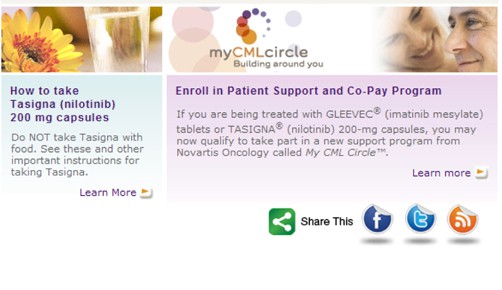
Digital Pharma: Novartis rapped for Facebook sharing
pharmafile | August 10, 2010 | News story | Medical Communications | Digital Pharma blog, Facebook, Novartis, Tasigna
Novartis has had its knuckles rapped by the FDA over the company’s use of social media sharing tools.
At issue is a Facebook sharing widget on the company’s US consumer website for Tasigna (nilotinib). This generated Novartis-created information about its chronic myloid leukemia drug for sharing on the popular social network.
In a letter to the manufacturer, the FDA’s Division of Drug Marketing, Advertising and Communications (DDMAC) said this shared content is misleading because it “makes representations about the efficacy of Tasigna but fails to communicate any risk information associated with the use of this drug”.
Tasigna is associated with a number of serious risks, detailed in boxed warnings on its packaging, such as sudden death, severe myelosuppression, liver function abnormalities and use in pregnancy.
The lack of risk information is highly significant, the DDMAC said, because of the number of people who may see the content.
The average Facebook user is connected to 130 friends, substantially increasing the possible reach of any information posted, and the site is approaching Google as the most popular US website. (In May it received more than 130,000 unique visitors to Google’s 179,000.)
“Each time a link is shared by one user, potentially hundreds of new people may see and/or click through on the link,” the DDMAC said in the letter.
The letter went on to say: “We also note multiple Tasigna web pages contain widgets that allow users to share content via other social media applications offered via the ‘Share This’ tool. Some of the content available to share through these other social media applications raise similar issues to those discussed in this letter.”
The lengthy charge sheet also sees Novartis accused of inadequately communicating Tasigna’s FDA-approved indication and implying it is better than other products.
“Referring to Tasigna as a ‘next generation’ treatment misleadingly suggests superiority over other tyrosine kinase inhibitors” when “this advantage has not been demonstrated by substantial evidence”, the DDMAC said.
Moreover, the promotional material was not submitted to the FDA 30 days before it was first put out – which is a violation of FDA regulations.
In a statement the company said: “Novartis takes the letter issued by the FDA very seriously and we have addressed its concerns by taking the direct and immediate action of taking down the widget referenced by the FDA.”
“Novartis will continue to have active discussions with the FDA to understand fully all of the concerns,” the manufacturer said. “We also will assess all of our web assets and materials based on these concerns.”
Novartis has previous problems with the FDA over its US product websites – in May this year it was rebuked for two websites the regulator considered “false and misleading”.
At issue then were Gistalliance.com and cmlalliance.com, which the FDA said effectively promoted Novartis’ Gleevec (Glivec outside the US) for an unapproved use, failed to disclose the drug’s risks and made unsubstantiated dosing claims.
Meanwhile, the FDA is still mulling over the thorny issue of pharma’s use of social media and the internet following last year’s hearing, and guidance is expected to be out by the end of this year.
Dominic Tyer is web editor for Pharmafocus and InPharm.com and the author of the Digital Pharma blog He can be contacted via email, Twitter or LinkedIn.
Related Content

PeptiDream and Novartis extend peptide discovery collaboration
PeptiDream has announced the expansion of its peptide discovery collaboration with Novartis Pharma AG.

Novartis shares new data about Fabhalta for IgAN treatment
Novartis has announced new results from a pre-specified interim analysis of its phase 3 APPLAUSE-IgAN …

Novartis shares new data for Zolgensma in children with SMA
Novartis has announced new data to continue the support of the clinical benefits of Zolgensma …







